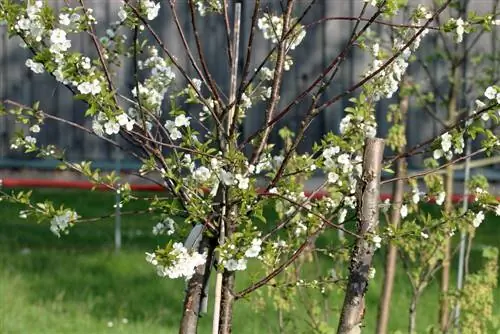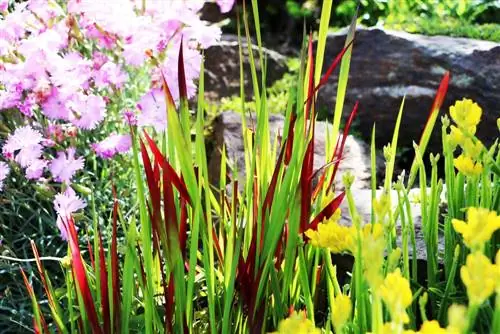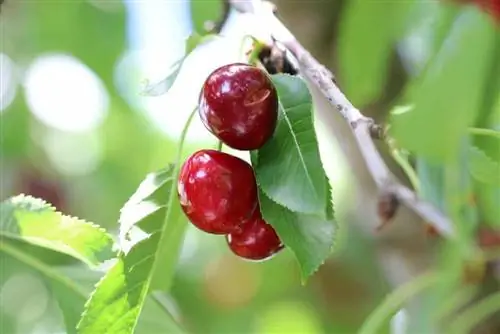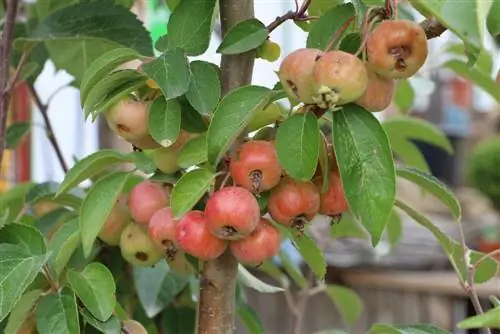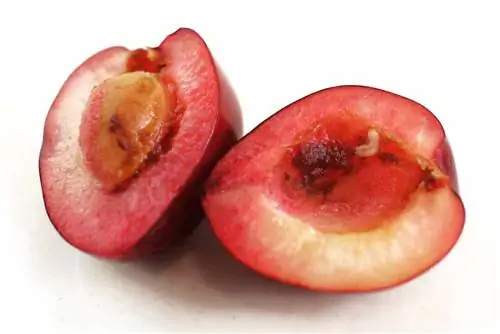- Author admin [email protected].
- Public 2023-12-17 03:39.
- Last modified 2025-06-01 06:48.
While the columnar cherry produces tasty fruits with appropriate care and proper pruning, the Japanese columnar cherry remains completely fruitless. It is a pure ornamental cherry that impresses with initially pink flowers that later turn white and striking yellow-orange autumn foliage. However, neither species can survive completely without cutting.
Best time for pruning
Columnar cherries are very vigorous plants that should be cut regularly. The right time depends on the age and condition of the plant as well as the type of cut. In addition, it makes a difference whether it is a fruiting columnar cherry or an ornamental tree. In contrast to the fruiting columnar cherry, which also tolerates severe cuts, the ornamental cherry should only be cut minimally.
The first pruning is often carried out in the tree nursery. Topiary pruning, which serves to maintain the growth habit, is carried out in spring and autumn. Immediately after the harvest in summer, maintenance pruning follows, which contributes to the formation of new fruit shoots. A rejuvenation cut is only necessary every few years in late summer, especially on old, long-neglected or heavily bare specimens.
Parenting cut - instructions
- Pruning is usually done at the nursery
- If not, it should be done before planting
- To do this, shorten the tree by about a third
- Next summer, select a strong, terminal central shoot as a trunk extension
- If growth exceeds 50 cm, cut the central shoot again in the same year
- Cut back side shoots that are longer than 30 cm that form by August
- Short shoots to 20 -30 cm
- Middle shoot remains untouched to avoid branching
- Pruning leads to denser but short branching
- The fruit wood develops on shoots along the main trunk
- Remove competing shoots at the tip of the leading drive except for the strongest one
- Or cut back to two eyes
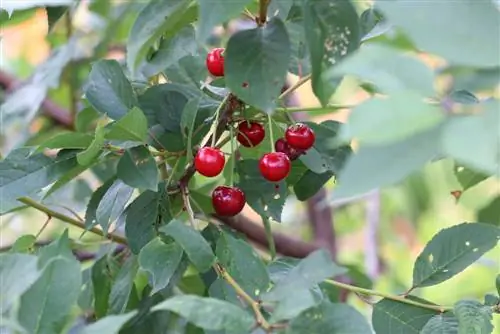
Intensive pruning measures are a must for this tree. If pruning is neglected, the poplar or columnar shape is lost relatively quickly and the cherry develops more and more into a bush. If the plant is to be trained as a completely single-shoot, leave the strongest central shoot and remove all side branches and competing shoots at the top of the main shoot. Young and herbaceous side shoots can also be pulled out around the end of May.
Tip:
It may make sense not to cut the shoots directly on the trunk, as appropriate side branches usually increase the fruit yield.
Procedure for topiary
The columnar cherry is cut into shape 1 - 2 times a year using topiary. For a typical columnar shape like that of the columnar apple, you pull out all competing shoots with your hands. Side shoots are cut off directly at the central shoot and fruit shoots that are too long or those that are longer than 30 - 35 cm are cut back to 20 - 25 cm. Competitive shoots on the main shoot are removed again immediately at the base.
If the shape is to resemble a poplar or a very slender Christmas tree, as is actually more characteristic of the columnar cherry, the stone shoots in the lower area should always be a little longer than the rest. To do this, shorten the lower side shoots to approx. 7-8 buds, the side shoots in the middle part to approx. 5-6 and the upper part to 2-4 buds.
Instructions for a maintenance cut
- The best time for maintenance pruning is after the harvest in summer
- Cut back all side shoots to 2 - 3 buds
- Fruit-bearing shoots will develop from this this year
- Additionally cut all diseased, weak, old, too close shoots from the tree
- Also remove heavily woody and crossing shoots
- If necessary, also shorten the leading drive
Columnar stone fruit like the columnar cherry only grows in a partially columnar shape but is still significantly narrower than usual fruit trees. For good stability it should not be higher than 250 cm. A corresponding height limitation occurs like with a columnar apple. You shorten the leading shoot to the desired size and divert it to a small side shoot. A new leading shoot develops from this side shoot. If this too has grown too high, the whole thing is repeated.
Tip:
In older columnar cherries, the central shoot should not be shortened if possible.
Making a rejuvenation cut
Old and thick wood on columnar cherries that have not been trimmed for a long time or have severe baldness in the lower area will not bear fruit. However, baldness is normal with age because the columnar cherry grows towards the light. In order to stimulate such plants to new growth and bring them back into shape, old wood is cut back to a length of 10 - 15 cm. The new growth that appears in spring is also occasionally shortened slightly. This leads to better branching. A severe pruning has the disadvantage that you have to do without flowers.
Tip:
Heavier pruning according to these instructions always carries the risk of gum flow and should therefore be done between the end of February and the beginning of March, after the main frost period. This applies equally to the normal columnar cherry and the ornamental columnar cherry.
What to pay attention to
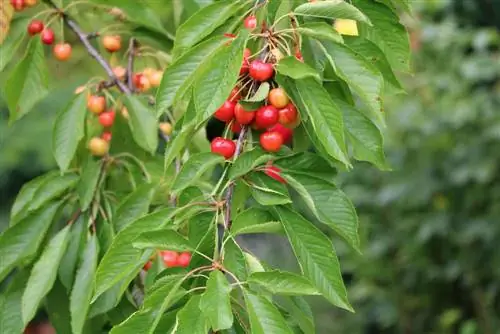
Pruning errors in the first few years are difficult to correct. A planting or training cut is not enough. This fruit tree can be trained with one or more shoots. Competitive shoots to the leading shoot should be removed regularly. When cutting, the temperatures should never be below freezing, the cuts should always be made vertically and directly at the base and larger cuts should be closed.
Spent flowers are not removed as this would reduce the fruit yield. The situation is different when the flowers wilt due to a disease called Monilia tip drought. Then not only the flowers, but all affected shoots should be cut back to he althy wood.
Columnar cherry not a typical columnar fruit
The naturally columnar shape can only be found in the columnar apple. It produces flowers and fruits directly on the trunk. The slender growth of cherry trees, which are offered as columnar fruit, is only partly genetically determined. For the most part, their special growth is the result of breeding selection.
They do not retain their shape permanently, grow more upwards with a stronger top and side shoot promotion and require significantly more care than, for example, a columnar apple. They grow up to 400 cm in height and 150 cm in width. The fruits do not grow directly on the trunk, but on the branches or side branches. In order to develop its typical slender growth habit and generally keep the tree in shape, the initial training pruning is just as important as regular shape and maintenance pruning.
Japanese columnar cherry/ornamental columnar cherry
The Japanese columnar cherry or ornamental columnar cherry is a purely ornamental tree and does not bear any fruit. Their flowering wood is active for several years. Pruning should be as minimal as possible, then it will grow most beautifully. Stronger cuts can destroy the typical growth habit. You only remove diseased, damaged and annoying branches and twigs. To avoid rubber flow, it is best to cut between February and March.

